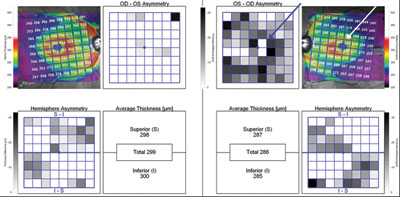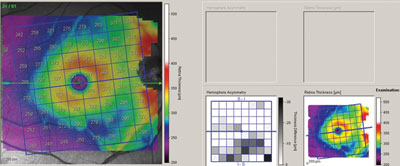New technology enables earlier glaucoma detection
Glaucoma is an insidious, chronic disease that cannot be cured — it can only be managed. The earlier it is detected, the less expensive and less invasive the techniques can be to halt progression and preserve the remaining visual field. Until recently, however, detection of early glaucoma was extremely difficult due to the limited sensitivity of imaging technology.
Glaucoma diagnosis with imaging devices traditionally focuses on optic nerve cupping and width of the neuroretinal rim. Highly reproducible measurements enables detection of change over time and thus objective measurement of glaucoma progression. However, due to the wide variation among the healthy population in optic nerve size, shape and total axonal count (and thus width of neuroretinal rim), it is difficult to differentiate early glaucoma from normal variation.
A visual field test has been the gold standard in detecting visual field losses for a number of years. However, multiple layers of ganglion cells within the paramacular region enable detection of the test light even when only one layer of ganglion cells remains. This allows for deterioration of five layers of ganglion cells before an abnormality is detected in the visual field. By measuring retinal thickness, loss and asymmetries can be detected much earlier than visual field abnormalities.
Spectral-domain OCT
Eye-tracking spectral-domain optical coherence tomography with Spectralis (Heidelberg Engineering) measures retinal thickness in the posterior pole using 61 lines (30° × 25° OCT volume scan) for each eye in a central 20° area, thus covering a larger area that corresponds more to the 24-2 visual field. This information is displayed as a color-coded thickness map for an 8 × 8 grid centered on the foveal pit. The color scale of the displayed retinal thickness map has been compressed to include more colors, thus permitting easy visual detection of small differences in retinal thickness.
The Spectralis posterior pole asymmetry analysis is particularly helpful because its maps provide an anatomical correlate to a visual field test. The posterior pole map also gives a reliable alternative to picking up changes that are more subtle and at an earlier stage of the disease.
A unique fovea-to-disc alignment technology automatically tracks and aligns peripapillary retinal nerve fiber layer (RNFL) circle scans, improving accuracy and reproducibility of RNFL measurements. Fovea-to-disc alignment technology helps overcome measurement errors due to changing head or eye position during scanning. This enables measuring change over time as well as analyzing RNFL abnormalities.
In addition, an age-adjusted RNFL thickness normative database has been cleared by the U.S. Food and Drug Administration, allowing me to detect differences compared with the general population, besides comparing with previous testing. The normative database is quite robust for the patient without significant refractive errors, and I use it not only to review when the result is within normal limits, but also to analyze the plot line. I look at the plot line when it is in the green or yellow range for any sudden dips into the abnormal red range. A small, sudden dip may not be identified in the average RNFL value of the quadrant but may indicate where there are focal losses. So besides looking at average values, I examine the plot line for indications of focal loss.
One of the greatest issues with glaucoma treatment today is the poor rate of patient compliance with the prescribed regimen. This new software provides a pictorial representation of what is happening with the eye that can be understood by patients. It is a tremendous tool in convincing patients that the threat of blindness is real, thus improving compliance. Because patients do not provide the input as they do in a visual field test, it is an objective analysis, and they are much more likely to accept the results. The visual representation of asymmetrical deterioration between eyes an incredibly convincing tool for patients and helps them understand the need to be consistent with their glaucoma medications.
Case studies
Case 1. A 52-year-old Caucasian man with glaucoma who had been diagnosed with ocular hypertension in the left eye 4 years ago was lost to follow-up. He had been advised to be on treatment but had abandoned it because he “did not feel the need for it.” He presented 1 year ago upon re-referral from his optometrist with minimal abnormality on visual field testing of his left eye and IOP in the left eye still in the high 20s. He once again questioned the need for treatment. However, once he saw the results of the Spectralis OCT asymmetry analysis and nerve fiber layer thickness measurements, he was convinced of the need for treatment. His attention was drawn to the loss of retinal thickness in the left eye when compared with the right eye. For the past year he has been compliant with his eye drops and comes in every 3 months to have his IOP checked.
 Case 1 patient with glaucoma who had been diagnosed with ocular hypertension in the left eye. Better compliance was obtained after he saw OCT results. Images: Asrani S |
Case 2. A 68-year-old Caucasian woman who had lost her left eye to endophthalmitis following a trabeculectomy was worried about the extent of the glaucoma in her right eye. She was using three different medications to control her IOP. Upon seeing the results of the macular thickness and nerve fiber layer thickness of her right eye, we were able to reassure her that the extent of loss from glaucoma was minimal, thus allaying her anxiety.
 The macular thickness results showed that the extent of loss from glaucoma was minimal in the right eye providing reassurance in a monocular patient. |
I now have the ability to analyze and measure both the nerve fiber layer and the macular retinal thickness with ease and reproducibility. This provides me with a much stronger ability to detect and treat glaucoma earlier.

- Sanjay Asrani, MD, can be reached at Duke Eye Center, 2351 Erwin Road, DUMC 3802, Durham, NC 27710; 919-684-8656; email: sanjay.asrani@duke.edu.
- Disclosure: Dr. Asrani receives lecture honoraria from Heidelberg Engineering.
